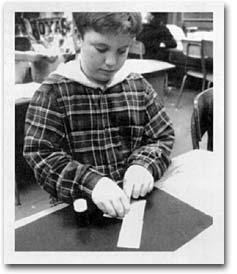|
|||||||
![]()

![]()
Students need to see the patterns of scaled growth in different shapes
before they can understand the universality of scaling patterns. In this
activity, they can investigate the relative growth of lengths, areas,
and volumes as cylinders are scaled up. In this case, we scale up by changing
the height of the cylinder and the diameter (or circumference) of the
base. In the activity, students will measure the three linear dimensions
of the cylinder. This is so that they will see that all linear dimensions
increase at the same rate as you scale up proportionately. Similarly,
they will be asked to measure two areas of the cylinder.
Students connect their experience with cylinders to the world outside
the classroom by giving examples of where they encounter cylinders in
their everyday life. These examples can include cans, poles, bottles,
and pipes. Having students make a list of cylinders makes a nice homework
assignment.
![]()
This activity requires a good deal of exacting work. It is best to do
it in two sessions. In the first session, students will measure the cylinder's
linear dimensions; in the second, they will measure for area and volume
dimensions.
After illustrating how the cylinders are made, have students predict what
kind of pattern of growth they might expect as they scale up. How much
like or unlike the patterns of cube growth do you expect the cylinder's
pattern to be? Then, ask the students to make their cylinders in two steps.
To build the cylinders, the students will draw and cut out rectangles
of paper which will form the cylinder sides. To create a uniform basis
for measurement in scaling, the students should use film canisters as
the basis for what will be called the unit rectangle. The length and width
of this unit rectangle will be doubled, tripled, quadrupled, etc., in
the scaling-up process.

